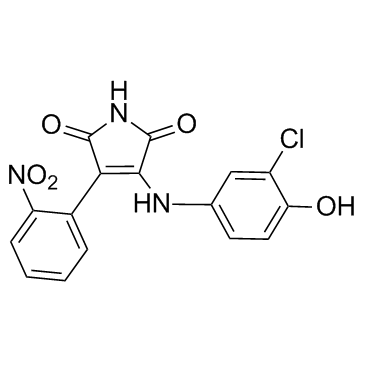SB 415286

SB 415286 structure
|
Common Name | SB 415286 | ||
|---|---|---|---|---|
| CAS Number | 264218-23-7 | Molecular Weight | 359.721 | |
| Density | 1.6±0.1 g/cm3 | Boiling Point | 595.8±50.0 °C at 760 mmHg | |
| Molecular Formula | C16H10ClN3O5 | Melting Point | N/A | |
| MSDS | Chinese USA | Flash Point | 314.1±30.1 °C | |
| Symbol |

GHS07 |
Signal Word | Warning | |
|
The antimicrobial protein S100A7/psoriasin enhances the expression of keratinocyte differentiation markers and strengthens the skin's tight junction barrier.
Br. J. Dermatol. 171(4) , 742-53, (2014) S100A7/psoriasin is a member of the S100 protein family and is encoded in the epidermal differentiation complex, which contains genes for markers of epidermal differentiation. S100A7/psoriasin is overexpressed in hyperproliferative skin diseases, where it is ... |
|
|
Inactivation of glycogen synthase kinase 3 promotes axonal growth and recovery in the CNS.
J. Neurosci. 28(36) , 8914-28, (2008) Axonal regeneration is minimal after CNS injuries in adult mammals and medical treatments to recover neurological deficits caused by axon disconnection are extremely limited. The failure of axonal elongation is principally attributed to the nonpermissive envi... |
|
|
Reduction of experimental colitis in the rat by inhibitors of glycogen synthase kinase-3beta.
Br. J. Pharmacol. 147(5) , 575-82, (2006) The effects of the inhibitors of glycogen synthase kinase-3beta (GSK-3beta), TDZD-8 and SB 415286, which can substantially reduce the systemic inflammation associated with endotoxic shock in vivo, have now been investigated on the acute colitis provoked by tr... |
|
|
Use of lithium and SB-415286 to explore the role of glycogen synthase kinase-3 in the regulation of glucose transport and glycogen synthase.
Eur. J. Biochem. 270(18) , 3829-38, (2003) Glycogen synthase kinase 3 (GSK3) is inactivated by insulin and lithium and, like insulin, Li also activates glycogen synthase (GS) via inhibition of GSK3. Li also mimics insulin's ability to stimulate glucose transport (GT), an observation that has led to th... |
|
|
A molecular study of pathways involved in the inhibition of cell proliferation in neuroblastoma B65 cells by the GSK-3 inhibitors lithium and SB-415286.
J. Cell. Mol. Med. 13(9B) , 3906-17, (2009) Pharmacological GSK-3 inhibitors are potential drugs for the treatment of neurodegenerative diseases, cancer and diabetes. We examined the antiproliferative effects of two GSK-3 inhibitors, lithium and SB-415286, on B65 neuroblastoma cell line. Treatment of B... |
|
|
GSK-3 inhibitors induce chromosome instability.
BMC Cell Biol. 8 , 34, (2007) Several mechanisms operate during mitosis to ensure accurate chromosome segregation. However, during tumour evolution these mechanisms go awry resulting in chromosome instability. While several lines of evidence suggest that mutations in adenomatous polyposis... |
|
|
Srebf1a is a key regulator of transcriptional control for adipogenesis.
Sci. Rep. 1 , 178, (2012) Adipogenesis is regulated by a complex cascade of transcriptional factors, but little is known about the early events that regulate the adipogenic program. Here, we report the role of the srebf1a gene in the differentiation of fibroblastic 3T3-F442A cells. We... |
|
|
Sidestream smoke exposure increases the susceptibility of airway epithelia to adenoviral infection.
PLoS ONE 7 , e49930, (2012) Although significant epidemiological evidence indicates that cigarette smoke exposure increases the incidence and severity of viral infection, the molecular mechanisms behind the increased susceptibility of the respiratory tract to viral pathogens are unclear... |